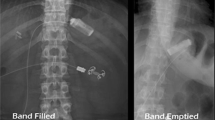Abstract
Background
Erosion, slippage, and esophageal dilatation have been acknowledged as typical long-term issues after lap banding. Yet it seems from our experience that isolated food intolerance has become a leading cause for band removal, although not reported as such in the literature.
Methods
There were 1,450 patients who have been operated on over 12 years (May 1995–May 2007). Food intolerance occurred in 41 cases (2.9%), representing 1/3 of the causes of band removal. The average time for diagnosis was 58 months (16–110). Seventeen cases occurred before 5 years of follow-up, and 25 after.
Results
The postoperative course has been uneventful in all cases of simple removal. No patient had re-banding after removal, one had vertical banded gastroplasty in another center, two a gastric bypass, one a BPD, and four had a sleeve gastrectomy at the same operative time as band removal. Food intolerance is rarely reported in the literature, or often attributed to “poor compliance” or “poor results” after lap banding. The background and symptoms of this entity should be separated from other issues, i.e., esophageal dilatation and band slippage. Gastric bypass is a valuable option after band removal, but like others, we prefer sleeve gastrectomy as a second step procedure, given the weight loss that has already been achieved in many cases.
Conclusion
Food intolerance after lap-banding is likely to represent the most common cause for band removal in the long run, although we do not know its future rate. From the literature and our experience, there is no clear cause to this complication in the majority of the cases; neither the type of band nor the type of procedure are sufficient explanations.
Similar content being viewed by others
References
Belachew M, Legrand MJ, Vincent V, et al. Laparoscopic adjustable gastric banding. World J Surg. 1998;22:955–63.
Dargent J. Laparoscopic adjustable gastric banding: lessons from the first 500 patients in a single institution. Obes Surg. 1999;9:446–52.
O’Brien PE, Dixon JB, Brown W, et al. The laparoscopic adjustable gastric band (lap-band): a prospective study of medium-term effects on weight, health and quality of life. Obes Surg. 2002;12:652–60.
Chevallier JM, Zinzindohoue F, Douard R, et al. Complications after laparoscopic adjustable gastric banding for morbid obesity: experience with 1000 patients over 7 years. Obes Surg. 2004;14:407–14.
Favretti F, Segato G, Ashton D, et al. Laparoscopic adjustable gastric banding in 1791 consecutive obese patients: 12-year results. Obes Surg. 2007;17:168–75.
Dargent J. Oesophageal dilatation after laparoscopic gastric banding: definition and strategy. Obes Surg. 2005;15:843–8.
Dargent J. Pouch dilatation and band slippage after adjustable gastric banding: is it still an issue ? (a 7 years experience). Obes Surg. 2002;9:446–52.
Busetto L, Valente P, Pisent C, et al. Eating pattern in the first year following adjustable gastric banding (ASGB) for morbid obesity. Int J Obes Relat Metab Disord. 1996;20:539–46.
Suter M, Calmes JM, Paroz A, et al. A new questionnaire for quick assessment of food tolerance after bariatric surgery. Obes Surg. 2007;17:2–8.
Suter M, Calmes JM, Paroz A, et al. A 10-year experience with laparoscopic gastric banding for morbid obesity: high long-term complication and failures rates. Obes Surg. 2006;16:829–35.
Poves I, Cabrera M, Marisdtany C, et al. Gastrointestinal quality of life after laparoscopic Roux-en-Y gastric bypass. Obes Surg. 2006;16:19–23.
Greenstein RJ, Nissan A, Jaffin B. Esophageal anatomy and function in laparoscopic gastric restrictive surgery: implications for patient selection. Obes Surg. 1998;8:199–206.
Paran H, Shiargan L, Shwartz I, et al. Long-term follow-up on the effect of silastic ring vertical gastroplasty in weight and comorbidities. Obes Surg. 2007;17:737–41.
Closset J, Mehdi A, Barea M, et al. Results of silastic ring vertical gastroplasty more than 6 years after surgery: analysis of a cohort of 214 patients. Obes Surg. 2004;14:1233–6.
Gumbs A, Pomp A, Gagner M. Revisional bariatric surgery for inadequate weight loss. Obes Surg. 2007;17:1137–45.
Dargent J. Surgical treatment of morbid obesity by adjustable gastric band: the case for a conservative strategy in the case of failure—a 9 year series. Obes Surg. 2004;14:986–90.
Baltasar A, Serra C, Perez N, et al. Laparoscopic sleeve gastrectomy: a multi-purpose bariatric operation. Obes Surg. 2005;15:1124–8.
Braghetto I, Korn O, Valladares H, et al. Laparoscopic sleeve gastrectomy: surgical technique, indications and clinical results. Obes Surg. 2007;17:1442–50.
Author information
Authors and Affiliations
Corresponding author
Rights and permissions
About this article
Cite this article
Dargent, J. Isolated Food Intolerance After Adjustable Gastric Banding: A Major Cause of Long-Term Band Removal. OBES SURG 18, 829–832 (2008). https://doi.org/10.1007/s11695-008-9495-x
Received:
Accepted:
Published:
Issue Date:
DOI: https://doi.org/10.1007/s11695-008-9495-x




